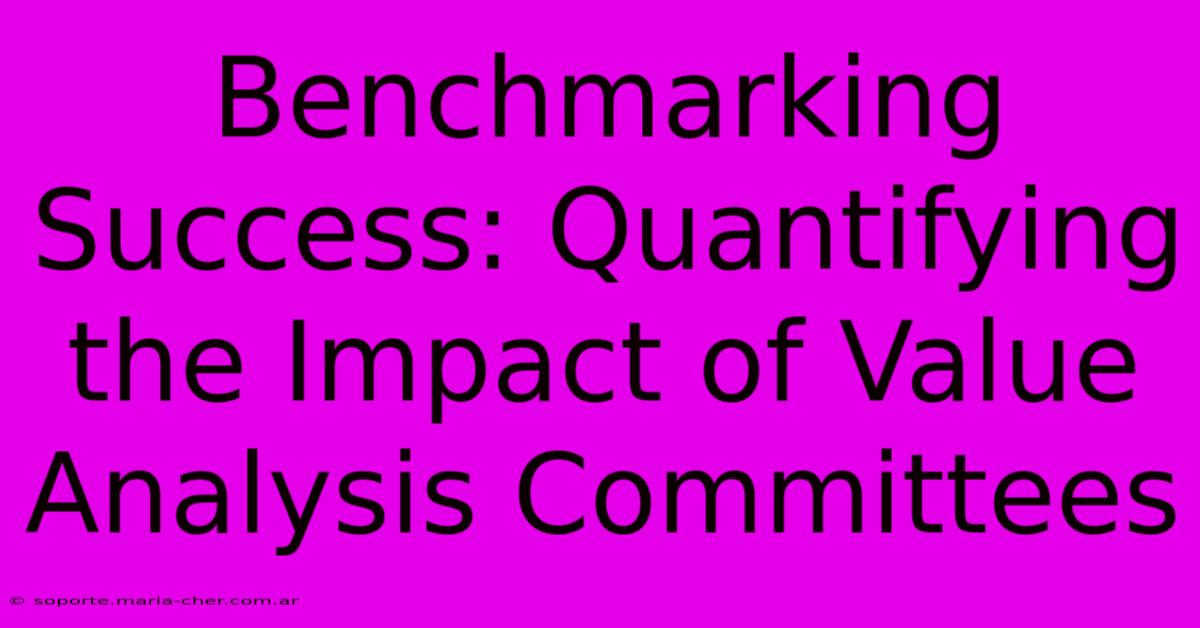Benchmarking Success: Quantifying The Impact Of Value Analysis Committees

Table of Contents
Benchmarking Success: Quantifying the Impact of Value Analysis Committees
Value Analysis (VA) Committees are increasingly recognized as crucial for organizations striving for operational efficiency and cost reduction. But how do you truly measure their impact? Simply stating that a VA committee exists isn't enough. To demonstrate their worth and secure continued support, you need quantifiable results. This article explores effective methods for benchmarking the success of your Value Analysis Committees and showcasing the tangible benefits they bring to your organization.
Understanding the Value of Value Analysis Committees
Before diving into benchmarking, it's vital to understand the core functions of a VA committee. These committees typically comprise members from various departments – engineering, procurement, manufacturing, finance – bringing diverse perspectives to problem-solving. Their primary goals include:
- Identifying Cost Reduction Opportunities: Pinpointing areas where costs can be reduced without sacrificing quality or functionality.
- Improving Product Design and Functionality: Streamlining processes and enhancing product design for improved efficiency and user experience.
- Enhancing Supplier Relationships: Fostering collaboration with suppliers to identify cost-saving opportunities within the supply chain.
- Boosting Innovation: Encouraging creative solutions and exploring new technologies to reduce costs and improve performance.
Key Metrics for Benchmarking VA Committee Success
Benchmarking requires a clear set of metrics. Instead of vague statements, focus on quantifiable data that directly reflects the committee's achievements. Here are some crucial metrics:
1. Cost Savings Achieved
This is the most direct and impactful metric. Track the total cost savings generated by the committee's recommendations implemented. Break this down further by:
- Project: Track cost savings for each individual project undertaken by the committee.
- Department: Identify which departments contributed the most significant cost savings.
- Type of Cost Reduction: Categorize savings (e.g., material cost reduction, process improvement, design changes).
Pro Tip: Always compare the achieved cost savings against the initial project budget or projected costs. This highlights the return on investment (ROI) of the VA committee.
2. Return on Investment (ROI)
Calculating ROI provides a powerful argument for the committee's continued existence. Divide the total cost savings by the total cost of running the VA committee (staff time, resources, etc.) to determine the ROI. A high ROI demonstrates a clear positive impact on the organization's bottom line.
3. Number of Projects Completed
Tracking the number of projects undertaken and completed within a specific timeframe provides a measure of the committee's productivity and efficiency. Compare this number to previous periods to identify trends and areas for improvement.
4. Implementation Rate of Recommendations
Not all recommendations will be implemented. Track the percentage of recommendations accepted and implemented. A high implementation rate suggests strong buy-in from management and effective communication within the committee. Analyze any discrepancies to understand why certain recommendations were rejected.
5. Time to Implementation
Measure the time elapsed between the recommendation and its successful implementation. A shorter time-to-implementation signifies an efficient and streamlined process. Analyze delays to identify bottlenecks and areas for process improvement.
6. Employee Engagement and Satisfaction
While harder to quantify directly, employee feedback on the VA committee's effectiveness can be valuable. Conduct surveys or focus groups to gauge employee satisfaction and engagement. This indirect metric can reveal issues impacting the committee's success.
Presenting Your Benchmarking Results
Once you've collected the data, present your findings clearly and concisely. Use visual aids like graphs and charts to highlight key trends and achievements. Focus on the story your data tells – how the VA committee directly contributes to the organization's financial health and operational efficiency.
Strong visuals and compelling narratives will be far more effective than simply presenting raw data.
Conclusion
Benchmarking the success of Value Analysis Committees is crucial for demonstrating their value and securing ongoing support. By using the right metrics and presenting your findings effectively, you can powerfully illustrate the significant impact these committees have on reducing costs, improving efficiency, and driving innovation within your organization. Remember that consistent monitoring and evaluation are vital for ongoing improvement and maximizing the ROI of your VA committee.

Thank you for visiting our website wich cover about Benchmarking Success: Quantifying The Impact Of Value Analysis Committees. We hope the information provided has been useful to you. Feel free to contact us if you have any questions or need further assistance. See you next time and dont miss to bookmark.
Featured Posts
-
Unveiling The Acronym East A Journey Into Uncharted Territory
Feb 11, 2025
-
Decode The Alphabet Of Ring Sizes A Monica Vinader Sizing Chart Just For You
Feb 11, 2025
-
Midtown East Breakthrough Study Uncovers The Missing Link To Optimal Brain Power
Feb 11, 2025
-
The Iconic Shots That Captured The Movement Gloria Steinems Photographic Legacy
Feb 11, 2025
-
Discover The Crown Jewel Of Frisco Homes Perry Homes Architectural Excellence
Feb 11, 2025
